Windsurfers’ concrete escape crops up in the untamed landscape of Karpathos
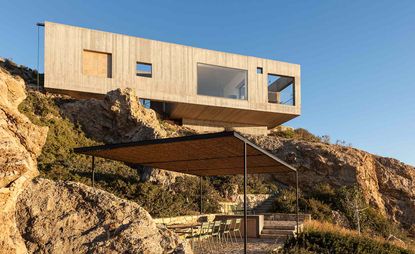
The world map through a surfer’s eyes is a constellation of perfect swells, beach geology and wind. Surf enthusiasts tend to gravitate towards very particular spots, even specific parts within a single beach. And there are the well-known surfer haunts – western France’s Biarritz even has its own museum for surfing, designed by Steven Holl (see W*146) – and the lesser-known. Karpathos, in Greece, definitely belongs to the latter category; the Aegean’s swell deficit means surfing here is entirely wind assisted.
The island, a three-and-a-half-hour ferry ride from the popular port of Rhodes, had long been a hidden gem, its pristine beaches largely unknown to the international tourist trail till about a decade ago. Now, this rocky outcrop is slowly starting to become a global windsurfing hotspot. A Paris-based pair of windsurfing aficionados – a Swede and a Frenchman – and their two children were way ahead of the curve when they started coming to Karpathos with their boards back in 2004.
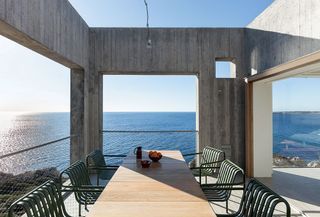
The open-air dining area off the kitchen frames views of the Aegean and typifies the house’s connection between inside and out.
Dreaming of a more permanent base on the island, they started looking for the perfect spot to build their family getaway. They found it through their friend, owner of the local surf station, Manolis Kritsiotis, in the bay of Afiarti, known for its strong summer winds and loyal and lively surfing community. The site, a steep lot split into two levels, overlooking a rocky cove, ticked all the boxes and they shook hands on it immediately.
They approached Stockholm-based practice OOAK, having found it online. Its three directors, Maria Papafigou, Marie Kojzar and Johan Annerhed, offered the ideal mix of international approach, modern architectural style and local knowledge (Papafigou is Greek). Their starting point was the ‘sparse, untamed and dramatic landscape’, say the trio.
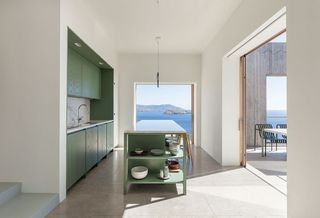
The bespoke kitchen serves as one of various colour accents throughout.
‘The question became how to introduce a foreign object – a house – into this spectacular landscape, enhancing its qualities without altering its character,’ says Papafigou. ‘Rather than trying to mimic the landscape, the house is gently placed on the site as an object, leaving the surroundings as untouched as possible. Landscape and building are perceived as two distinct elements that together create a new entity – much in the way a perfect shell fuses with a rock over time and gradually becomes part of the rock formation.’
The brief outlined a summer retreat with three bedrooms and a guest room, as well as living spaces and storage areas for all the owners’ surfboards and related kit. An opening at the heart of the house serves as a hub for meditation, yoga and karate practice, and offers an outdoor space that remains sheltered even during the region’s very strong gales.
A terrace is located on the more protected lower plateau of the site, connected to the house via a series of external steps. The main structure, made mostly of cast-in-situ concrete, spreads across the upper level and cantilevers over the cliff, taking full advantage of the views to the sea. A series of ‘voids’ throughout the layout strengthens the connection between inside and out.
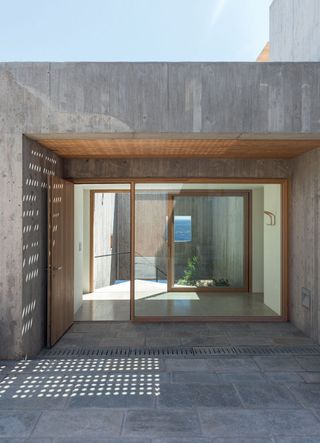
A door off the central courtyard leads to steps down to the lower terrace and draws guests in with a glimpse through to the sea.
‘Karpathos does not have the strong building regulations most other Greek islands have. This gave us the chance to reinterpret what a Greek holiday house can be,’ says Annerhed. A stark, rather enigmatic, street façade with a big wooden door leads to steps down to the central courtyard, offering access to all the different parts of the house. Views towards the water are carefully controlled throughout. Openings build up to the large picture window that frames the blue of the Aegean Sea and dominates the living room.
The generous open-plan living space takes up most of the main level, where the three bedrooms are also located. A smaller upper floor hosts the guest suite. Natural oak lines the windows, peach pine was used for the shutters, and river gravel covers the roof. Local stone was employed for the paving and retaining walls, creating a material composition that contrasts rough and smooth, natural and manmade. Stronger colours are used as accents.
‘We were inspired by the use of colour in traditional Greek houses,’ explains Annerhed. So, for example, the kitchen is green, the sofa is petrol blue, and different Greek marbles add texture around the house. All the interiors were composed by OOAK, including the furniture selection; the living room sofa, all dining tables, the sofa table, beds, desks, kitchen, and more, are all bespoke.
Sea, sun and contemporary architecture converge in this one-of-a-kind holiday home. And the best part? ‘We had a unique connection with the client, there was an immediate and mutual trust,’ says Papafigou. ‘We shared a fascination for the landscape, and the view of an ideal life around nature and simple things. We felt the same excitement about creating something special. This gave us the freedom to create something unlike anything they had imagined.’
As originally featured in the November 2018 issue of Wallpaper* (W*236)
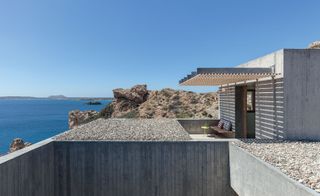
The guest suite is set on the upper level, looking out over the roof, lined with river gravel.
INFORMATION
For more information, visit the OOAK website
Wallpaper* Newsletter
Receive our daily digest of inspiration, escapism and design stories from around the world direct to your inbox.
Ellie Stathaki is the Architecture & Environment Director at Wallpaper*. She trained as an architect at the Aristotle University of Thessaloniki in Greece and studied architectural history at the Bartlett in London. Now an established journalist, she has been a member of the Wallpaper* team since 2006, visiting buildings across the globe and interviewing leading architects such as Tadao Ando and Rem Koolhaas. Ellie has also taken part in judging panels, moderated events, curated shows and contributed in books, such as The Contemporary House (Thames & Hudson, 2018), Glenn Sestig Architecture Diary (2020) and House London (2022).
-
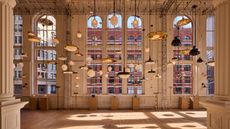 A celestial New York exhibition showcases Roman and Williams’ mastery of lighting
A celestial New York exhibition showcases Roman and Williams’ mastery of lightingLauded design studio Roman and Williams is exhibiting 100 variations of its lighting ‘family tree’ inside a historic Tribeca space
By Dan Howarth Published
-
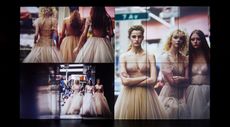 ‘He immortalised the birth of the supermodel’: inside Dior’s career-spanning retrospective of photographer Peter Lindbergh
‘He immortalised the birth of the supermodel’: inside Dior’s career-spanning retrospective of photographer Peter LindberghOlivier Flaviano, curator and head of Paris’ La Galerie Dior, talks us through a new Peter Lindbergh retrospective, which celebrates the seminal German photographer’s longtime relationship with the French house
By Jack Moss Published
-
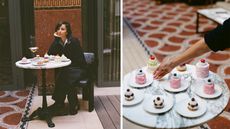 Take a bite: Laila Gohar and The Luxury Collection’s ‘Cakes & Candles’ are a sweet treat for the senses
Take a bite: Laila Gohar and The Luxury Collection’s ‘Cakes & Candles’ are a sweet treat for the sensesLaila Gohar’s six cake-inspired candles draw on The Luxury Collection’s hotels around the world – where guests can enjoy matching edible confections
By Tianna Williams Published
-
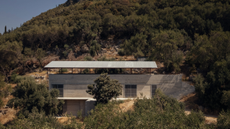 A breezy Greek island retreat lets the outdoors in
A breezy Greek island retreat lets the outdoors inOpen to the elements, an island retreat in Corfu by Invisible Studio was designed to suit the local climate, using metal mesh screens rather than windows
By Léa Teuscher Published
-
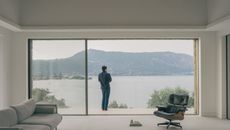 A Corfu house balances local vernacular and 21st-century minimalism
A Corfu house balances local vernacular and 21st-century minimalismCorfu House, a sensitive and minimalist holiday home, has been recently completed on the Greek island as a collaboration between architects Tony Wynbourne, Georgios Apostolopoulos and engineer Makis Gisdakis
By Ellie Stathaki Published
-
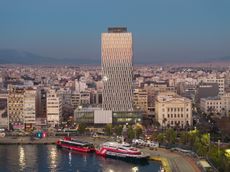 Piraeus Tower is a Greek high-rise icon revived through sustainable strategies
Piraeus Tower is a Greek high-rise icon revived through sustainable strategiesThe restoration of the Piraeus Tower is completed in Greece, revealing a revived façade by local architecture studio PILA
By Ellie Stathaki Published
-
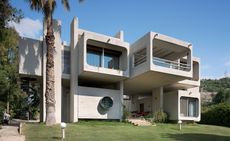 Remembering Alexandros Tombazis (1939-2024), and the Metabolist architecture of this 1970s eco-pioneer
Remembering Alexandros Tombazis (1939-2024), and the Metabolist architecture of this 1970s eco-pioneerBack in September 2010 (W*138), we explored the legacy and history of Greek architect Alexandros Tombazis, who this month celebrates his 80th birthday.
By Ellie Stathaki Published
-
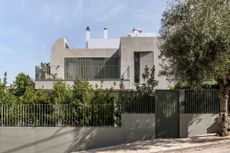 Tour House D in Athens, where interiors are peachy keen
Tour House D in Athens, where interiors are peachy keenDesigned by Cometa Architects, House D in Athens is full of curvy, colourful character
By Ellie Stathaki Published
-
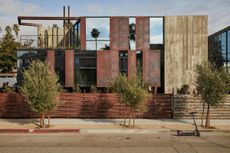 Sun-drenched Los Angeles houses: modernism to minimalism
Sun-drenched Los Angeles houses: modernism to minimalismFrom modernist residences to riveting renovations and new-build contemporary homes, we tour some of the finest Los Angeles houses under the Californian sun
By Ellie Stathaki Published
-
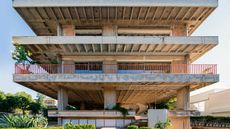 Three Object Apartment embraces raw concrete honesty in the heart of Athens
Three Object Apartment embraces raw concrete honesty in the heart of AthensThree Object Apartment by DeMachinas is a raw concrete home in Athens, which confidently celebrates its modernist bones
By Ellie Stathaki Published
-
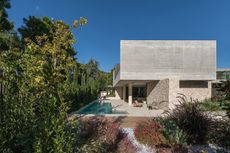 Residence in Dionysos was conceived as a minimalist ‘cave refuge’ outside Athens
Residence in Dionysos was conceived as a minimalist ‘cave refuge’ outside AthensResidence in Dionysos by Desypri & Misiaris Architecture is a family home designed as a minimalist refuge among the surrounding nature's pine tree-filled slopes
By Ellie Stathaki Published